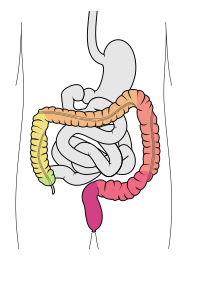
Photo from wikipedia
ObjectivesInvasive treatment of tumors adjacent to large hepatic vessels is a continuous clinical challenge. The primary aim of this study was to examine the feasibility of ablating liver tissue adjacent… Click to show full abstract
ObjectivesInvasive treatment of tumors adjacent to large hepatic vessels is a continuous clinical challenge. The primary aim of this study was to examine the feasibility of ablating liver tissue adjacent to large hepatic and portal veins with magnetic resonance imaging–guided high-intensity focused ultrasound (MRgHIFU). The secondary aim was to compare sonication data for ablations performed adjacent to hepatic veins (HV) versus portal veins (PV).Materials and methodsMRgHIFU ablations were performed in six male land swine under general anesthesia. Ablation cells of either 4 or 8 mm diameter were planned in clusters (two/animal) adjacent either to HV (n = 6) or to PV (n = 6), with diameter ≥ 5 mm. Ablations were made using 200 W and 1.2 MHz. Post-procedure evaluation was made on contrast-enhanced MRI (T1w CE-MRI), histopathology, and ablation data from the HIFU system.ResultsA total of 153 ablations in 81 cells and 12 clusters were performed. There were visible lesions with non-perfused volumes in all animals on T1w CE-MRI images. Histopathology showed hemorrhage and necrosis in all 12 clusters, with a median shortest distance to vessel wall of 0.4 mm (range 0–2.7 mm). Edema and endothelial swelling were observed without vessel wall rupture. In 8-mm ablations (n = 125), heat sink was detected more often for HV (43%) than for PV (19%; p = 0.04).ConclusionsAblations yielding coagulative necrosis of liver tissue can be performed adjacent to large hepatic vessels while keeping the vessel walls intact. This indicates that perivascular tumor ablation in the liver is feasible using MRgHIFU.Key Points• High-intensity focused ultrasound ablation is a non-invasive treatment modality that can be used for treatment of liver tumors.• This study shows that ablations of liver tissue can be performed adjacent to large hepatic vessels in an experimental setting.• Liver tumors close to large vessels can potentially be treated using this modality.
Journal Title: European Radiology
Year Published: 2019
Link to full text (if available)
Share on Social Media: Sign Up to like & get
recommendations!